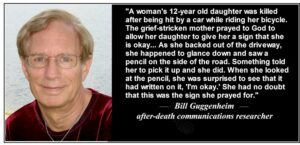This site uses affiliate links to Amazon.com Books for which IANDS can earn an affiliate commission if you click on those links and make purchases through them.
1. Introduction to After-Death Communications
Have you ever been contacted by a loved one in a dream shortly after they died? Or have you ever heard their voice, or sensed their presence, or experienced a “sign” in the form of a remarkable coincidence soon after a loved one dies. Tens of millions of Americans have. Such after-death communications (ADCs) are defined as: “spiritual experiences which occur when a person is contacted directly and spontaneously by a family member or friend who has died, without the use of psychics, mediums, rituals, or devices of any kind.”
2. Bill and Judy Guggenheim’s ADC Research
During their seven years of research, Bill and Judy Guggenheim (www.after-death.com) collected more than 3,300 firsthand reports from people who believe they have been contacted by a deceased loved one. On the Guggenheim’s website they state how it’s estimated that 60-120 million Americans, 20-40% of the population of the United States, have had one or more ADC experiences. Therefore, ADCs provide convincing new evidence for life after death. Their book, Hello From Heaven, is among the very best books this webmaster, Kevin Williams, has ever read in his life. The Guggenheim’s groundbreaking study and book documents a plethora of such ADC experiences and categorizes them by types. The following excerpts are reprinted by permission from their wonderful book revealing some of these amazing after-death communications.
3. The Most Frequent Types of After-Death Communications
Based upon Bill and Judy Guggenheim’s groundbreaking after-death communication research, the following list contains the twelve most frequent types of after-death communication people report having with their deceased loved ones. Combinations of these twelve types of contact are also reported.
Types of After-Death Communications
- Sensing their presence
- Hearing their voice
- Feeling their touch
- Smelling their fragrance
- Seeing their apparition
- Seeing a flat vision of them like a photo
- Experiencing one of these types while half-asleep
- Having a visitation dream
- Having an out-of-body experience and meeting them
- Receiving a telephone call in a dream involving lucid two-way conversations
- Experiencing physical activity such as lights, TVs, and radios going on and off
- Receiving a symbolic message, sign, meaningful coincidence, or synchronicity
The #12 types of ADC of receiving a symbolic message or “sign from heaven” in the form of a meaningful coincidence or synchronicity is a relatively common type of ADC which the Guggenheim’s refer to as “symbolic ADCs.” Many people report receiving a special sign coincidental to some time related to a deceased loved one thereby affirming their loved one has survived physical death and continues to live in another dimension of existence. The types of symbols involved in such symbolic ADCs include butterflies, rainbows, flowers, different species of birds and animals, and any number of inanimate objects such as a song, for example, which is a favorite song of a recently deceased loved one which is heard coincidentally at some special time after that loved one’s death. According to the Guggenheim study, whether the sign comes immediately after the loved one’s death, or takes days ,or weeks, or years, most people intuitively recognize their sign right away and feel it was intended just for them. Some people report they were sent a sign spontaneously as a gift, while others ask or pray to receive one. Depending on their belief system, they may ask their deceased loved one to give them a sign, or they may pray to God or the “universe” for one. Symbolic ADCs provide much hope to those who are grieving deeply, especially bereaved parents and the widowed. But because they are a symbolic form of communication, the receiver must interpret his or her own experience and assign personal meaning to it (Guggenheims, 1997). Because I had read the Guggenheim’s book, Hello From Heaven, about ADCs before I began receiving ADCs of my own, I was able to recognize what was happening and began documenting what was happening.
4. Symbolic After-Death Communications Involving Synchronicity
Synchronicity or “meaningful coincidence” is a concept first introduced by the famous psychologist Carl Jung whose near-death experience (NDE) is profiled on this website. Jung identified events to be a “synchronicity” if they occur with the following characteristics: (1) the events occur simultaneously, (2) the events are meaningfully related, and (3) the events are not connected by cause. Following discussions with the his friends, the great physicists Albert Einstein and Wolfgang Pauli, Jung believed there were parallels between synchronicity and aspects of relativity theory and quantum mechanics. In 1952 Jung published a paper “Synchronicity: An Acausal Connecting Principle” in a volume which also contained a related study by Wolfgang Pauli. Jung’s belief was that, just as events may be connected by causality, they may also be connected by meaning.
Jung used the concept of synchronicity in arguing for the existence of the paranormal. Synchronicity is a principle which Jung believed gave conclusive evidence for his concepts of universal archetypes and the collective unconscious. Synchronicity describes a deeper governing order which underlies the whole of human experience and history — social, emotional, psychological, and spiritual. Jung believed life was not a series of random events but rather an expression of this deeper, underlying governing order which he and Wolfgang Pauli referred to as Unus mundus (Latin for “one world”). Jung believed the self-realization of being embedded in this universal wholeness was more than just an intellectual exercise, but also had elements of a spiritual awakening such as a person might have after experiencing a synchronicity associated with an ADC. Jung also believed synchronicity served a role similar to dreams with the purpose of shifting a person’s egocentric conscious thinking to greater wholeness.
5. The Most Frequent Messages Expressed By Departed Loved Ones
According to the Guggenheim’s research, the purpose of such contact is to offer comfort, reassurance, and hope to surviving family and friends. They want us to know they’re still alive and that we’ll be reunited with them when our time comes. Their most frequent messages, expressed verbally or non-verbally, are:
Most Frequent Messages
I’m okay. Don’t grieve for me.
I’m fine. Please let me go.
Everything is okay. I’m happy.
I love you. I’ll see you again.
Everything will be all right. Go on with your life.
I’m watching over you. Please forgive.
I’ll always be there for you. Thank you.
Don’t worry about me. Goodbye
6. Examples of Various Types of After-Death Communications
In the ground-breaking book entitled Hello From Heaven, the authors Bill and Judy Guggenheim (former NDE researchers), describe how they collected more than 3,300 firsthand reports from people who believe they were contacted by a loved one from the Other Side. In doing so, they founded a new field of research on after-death communications. I read this book many years ago, and since then, I have been recommending the book to people who would email me about the loss of a loved one. Had I not read this book, I wouldn’t have recognized my own family’s after-death communications that occurred. You can read examples of some of the more unusual ADCs from this excellent book. To better understand what ADCs are all about, the following are brief summaries of four actual examples:
Four Examples of After-Death Communications
Example 1: Receiving a Sign From Heaven
A woman’s 12-year old daughter was killed after being hit by a car while riding her bicycle. The grief-stricken mother prayed to God to allow her daughter to give her a sign that she is okay. She prayed this prayer all day and nothing happened. That night she had to attend a meeting at church. As she backed out of the driveway, she happened to glance down and saw a pencil on the side of the road. Something told her to pick it up and she did. When she looked at the pencil, she was surprised to see that it had written on it, “I’m okay.” She had no doubt that this was the sign she prayed for. (p. 224, Bill Guggenheim’s book, Hello From Heaven)
Example 2: Sensing Their Presence
A woman did not get along well with her mother and when her mother died, she was saddened about their sour relationship. Sometime after the funeral, the woman was laying in bed grieving when all of a sudden she strongly sensed her mother in the room. At first, she thought she was hallucinating. The women sensed her mother’s arms around her and comforted her for about 15 minutes. She knew it was her mother comforting her and helping her through her pain. (p. 57, Bill Guggenheim’s book, Hello From Heaven)
Example 3: Hearing Their Favorite Song
A woman lost a close friend. A week later at a Christmas party, she put a Christmas CD on the stereo. But the song she wanted to hear on the CD which helped her with her grief wouldn’t play. She became aggravated and turned on the radio instead. Immediately, the song “Wherever You Will Go” came on the radio – a song she identified with her deceased friend. She already had several such experiences with this song since her friend died. Immediately after that song was over, the song that wouldn’t play on her Christmas CD came on the radio! She couldn’t believe it! She began to cry because she knew that it was her friend giving her another sign from heaven that he is still around. (from Bill Guggenheim’s website)
Example 4: Seeing Their Apparition
Rosalyn is a chemical dependency counselor in Washington who had an apparition ADC. When she was seven years old, her alcoholic uncle sexually abused her for two years which was very traumatic for her. By the time she was seventeen, she was an alcoholic herself, and later became a heavy drug user. She eventually sobered up, but in order to stay sober, she had to go back through her past and deal with the people, places, and things that had harmed her. Besides her need to deal with her sexual abuse, she also wanted to make peace with her uncle. She chose to believe that if her uncle had been sober he wouldn’t have abused her. So she wrote her uncle a letter and told him how she felt and told him that she held nothing against him. However, she never learned whether or not he received it. As a Christian, she would pray that her love would cover her uncle’s sin. Then one day, she awoke from sleep and turned over. To her amazement, she saw Jesus and her uncle next to her bed. She could only see their heads and shoulders. There was also a light behind both of them. There was an overwhelming presence of love but also a seriousness. Jesus asked her a question that she heard in her mind. There was an authority and power in his voice, yet a gentleness as well. Jesus asked her, “Do you hold anything against this man?” She told him, “No, I don’t.” Then Jesus turned and looked at her uncle and said, “Neither do I hold anything against him.” Rosalyn knew then that her uncle was at peace and with Jesus. A couple of days later, she received a letter from her mother telling her that Uncle Mickey had died. (p. 371, Bill Guggenheim’s book, Hello From Heaven)


















